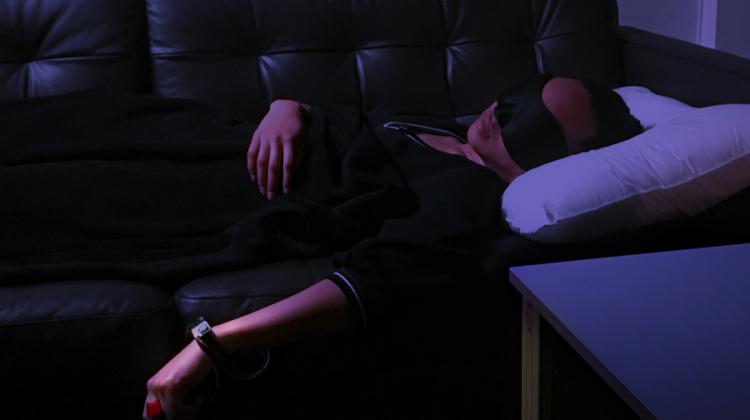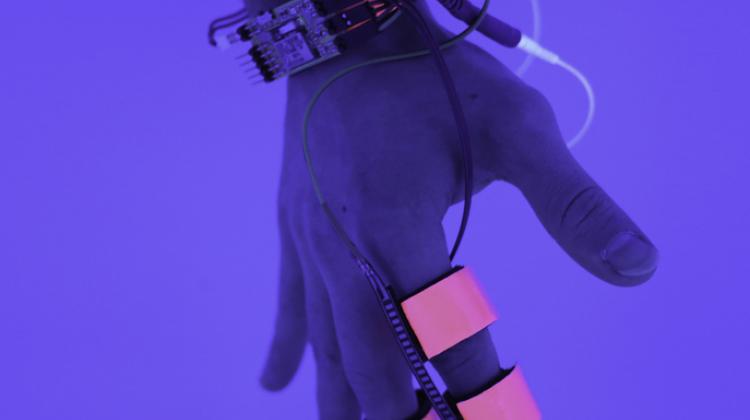That moment when you’re nodding off is a sweet spot for creativity

The subject is suspended in a semi-lucid state in which dreams can be guided toward a particular topic. Credit: Fluid Interfaces Group, MIT Media Lab

During sleep onset, a window of opportunity for interfacing with sleep arises in the form of hypnagogia, a semi-lucid sleep state where we all begin dreaming before we fall fully unconscious. Dormio is an inexpensive and open source sleep tracking technology tailored to hypnagogia. Credit: Oscar Rosello
Anne Trafton | MIT News Office
Feeling stuck on a problem that seems unsolvable? You may come up with a creative solution after a short nap — very short, according to a new study from MIT and Harvard Medical School researchers.
During the phase when you’re drifting between sleep and waking, a state known as sleep onset, the creative mind is particularly fertile, the researchers showed. They also demonstrated, for the first time, that when people are prompted to dream about a particular topic during that sleep phase, they perform much more creatively when later asked to perform three creativity tasks around that topic.
“When you are prompted to dream about a topic during sleep onset, you can have dream experiences that you can later use for these creative tasks,” says Kathleen Esfahany, an MIT senior and one of the lead authors of the study.
People who received this prompting, known as “targeted dream incubation,” generated more creative stories than people who napped without a specific prompt or people who stayed awake. The findings suggest that during this dream state, the brain makes more wide-ranging connections between disparate concepts, providing a boost in creativity, the researchers say.
“If you access this brain state, you can be more creative in your waking life,” says Adam Haar Horowitz, a postdoc in the MIT Media Lab and a lead author of the study, which appears today in Scientific Reports.
Robert Stickgold, a professor of psychiatry at Harvard Medical School, and Pattie Maes, a professor in MIT’s Media Lab, are the principal investigators who led this study. Tomás Vega Gálvez, a former MIT graduate student in Maes’ research group, is also an author.
Creative insight
For many years, anecdotal evidence has suggested that the earliest stage of sleep, also known as N1 or hypnagogia, is a fertile breeding ground for creative ideas. Thomas Edison, among others, often took advantage of this state. When struggling with a thorny problem, he would sit down for a nap while holding a metal ball in his hand. Just as he fell asleep, the ball would fall out of his hand and wake him up, and when he woke, he often had a new solution in mind.
In 2021, a study from the Paris Brain Institute offered experimental evidence that sleep onset helps generate that kind of creative insight. In that study, participants who briefly fell into N1 were much more likely to succeed in discovering an easy way to solve a number-related task.
The MIT team wanted to see if they could extend that finding into realms more commonly associated with creativity, such as storytelling. They also wanted to explore whether they could guide the content of people’s dreams and how that guided content might affect the creative process.
“One of the goals of our group is to give people more insights into how their brain works, and also what their cognitive state is and how they may be able to influence it,” Maes says.
Toward that end, Horowitz worked with a team of fellow MIT Media Lab students in developing a device called Dormio that could be used for targeted dream incubation. The device includes a glove that measures three physiological markers of sleep — changes in muscle tone, heart rate, and skin conductance — and communicates them to a smartphone or laptop app.
As someone wearing the glove enters the N1 state, the app prompts them to dream about a specific topic. After a few minutes, when the wearer begins to enter the next stage of sleep, the app wakes them up, asks them to report what they were dreaming about, and records their response.
“Before that device, there were no causal studies where people could guide dreams toward certain topics and then look at post-sleep behavior,” says Esfahany, who is majoring in computation and cognition, a program offered jointly by MIT’s departments of Brain and Cognitive Science and of Electrical Engineering and Computer Science.
Dream incubation
The researchers first showed that they could use the Dormio device to perform targeted dream incubation in a 2020 paper. In their new study, they used this approach to explore how dreaming, and targeted dreaming in particular, influences creativity.
For this study, the researchers divided 49 participants into four groups. One group was given 45 minutes to nap, while the Dormio device prompted them to dream about a tree and then recorded their description of their dreams. Each time a dream was reported, the wearer was encouraged to go back to sleep and again prompted to dream about a tree.
Participants in another group napped using the device but were instructed only to observe their thoughts. Two other groups remained awake during the 45-minute period: One of these received prompts to think about trees, while the other was told to observe their thoughts.
After 45 minutes of napping or being awake, subjects were asked to perform three tasks, which have been previously established to correlate with creativity. First was a storytelling task, where the participants were asked to write a creative story including the word “tree.”
Study participants who were instructed to dream about trees produced the most creative stories, as assessed by human raters who read the stories and were unaware of which participants were in each group. Additionally, people who napped but were not given a specific prompt also showed more creativity than people who had stayed awake throughout the experiment.
People who were told to dream about trees also had the highest scores on two other measures associated with creativity, known as divergent thinking tasks. In one task, participants were asked to list as many creative uses as they could think of for a tree. In the second, people were given a list of nouns and asked to respond with the first verb that came to mind for each one.
When the researchers analyzed all three tasks, participants who napped with targeted dream incubation performed 43 percent more creatively than participants who napped without targeted dream incubation, and 78 percent more creatively than those who stayed awake without incubation.
The researchers also found that within the group of people told to dream about trees, those who had a higher number of dreams about trees also showed more creativity in their stories. These people also incorporated much of the content of their dreams in their stories.
“That evidence suggests that it's not just being in the N1 sleep state that makes people more creative. People are more creative because they are also harnessing the dreams that are occurring in that sleep state,” Esfahany says.
Harnessing the mind
The researchers also found that people who napped had the best performance on another measure related to creativity, known as semantic distance. Semantic distance is a measure of how far apart two words or concepts are in their meaning. For example, mother and father would be closer together, while mother and frog would be farther apart.
In the verb generation and alternative use tasks, the researchers found that people who napped produced combinations of words with much greater semantic distance than those who stayed awake. This supports the theory that during sleep onset, the brain brings together concepts that it might not connect during waking hours.
“If we guide your thinking during that period, then that opportunity to search for farther apart concepts is also guided,” Esfahany says. “If we guide you to dream about a tree, you end up having much broader associations about trees, and then all of that can manifest in your creative responses.”
Targeted dream incubation doesn’t require the Dormio device, the researchers emphasize; it can be done with any device that can track sleep and play and record sound. They have also created a simpler version of their protocol, which uses a timer instead of tracking sleep states and is available online for anyone who wants to use it.
“That's really our goal with a lot of this work: to give people more tools to learn how to harness their own minds,” Maes says.
The researchers are now exploring whether they can expand their dream incubation protocol to later sleep stages, such as REM. They are also looking into making the protocol easier to perform and extending it into other domains such as helping to treat nightmare-related distress.
The research was funded by Consortium Funding at the MIT Media Lab and the National Institutes of Health. The team that originally developed the Dormio device includes Vega Gálvez, Ishaan Grover, Pedro Reynolds-Cuéllar, Oscar Rosello, Abhinandan Jain, Eyal Perry, Matthew Ha, and Christina Chen.


